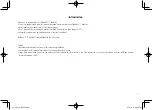
End of Message Tape Sequence
An “end of message” tape sequence is a method for automatically turning off a
tape recorder (connected to the audio port) at the end of a message, and
positioning the tape for the start of the next message. This allows a single
message to be played each time the audio port is accessed.
Refer to Figure 3. The sequence consists of a 3-second (minimum) silent period
followed by a single short word or tone. When the TLS-4A detects 3 seconds of
silence, it removes the audio path between the audio port and the telephone.
When it hears the cue tone or word, it opens the control contacts of the audio
port to turn the recorder off, leaving the tape at the beginning of the next
message.
If the telephone that has accessed the audio port hangs up before the end of
message sequence is found, the tape will continue to run and cue itself for the
next message. If no audio was heard from the tape (if the tape was blank or
not connected), the control will be turned off when the phone hangs up.
Multiple copies of the message may be consecutively recorded on a long tape
(which would need to be manually rewound at the end of the tape), or a single
message may be recorded on a continuous loop tape.
Telephone Line Simulator 4A
Page 16
Figure 3 End of Message Tape Sequence
1. Silence
2. Voice
3. Silence
(3 sec)
4. Single cue word or tone
5. Silence
6. Next
1. Audio Port Permission. Audio connected, tape starts.
2. First recorded message.
3. After 3 seconds of silence, the audio path is disconnected.
4. Cue word or tone. Indicates that start of next message is approaching.
The cue is not heard in the telephone.
5. Tape is stopped at end of cue, before beginning of next message, and
remains
stopped awaiting next access.
6. Next message on tape.
















































